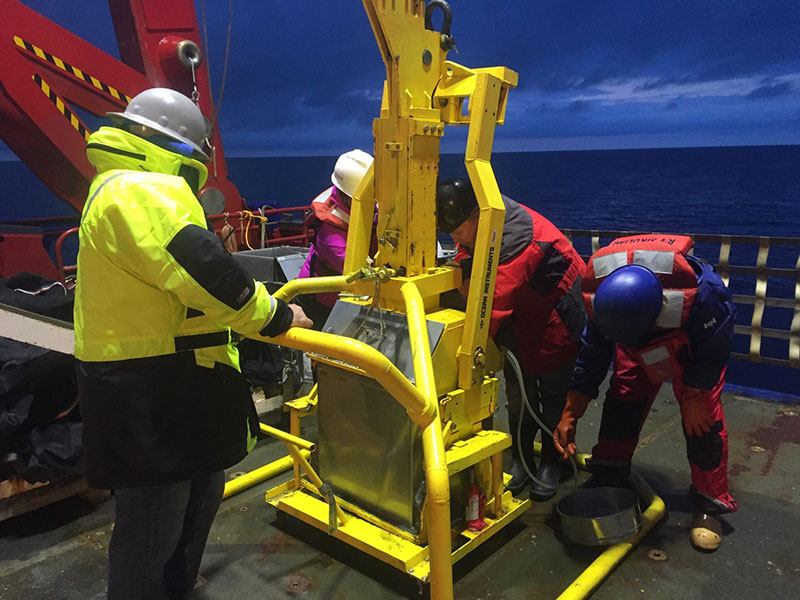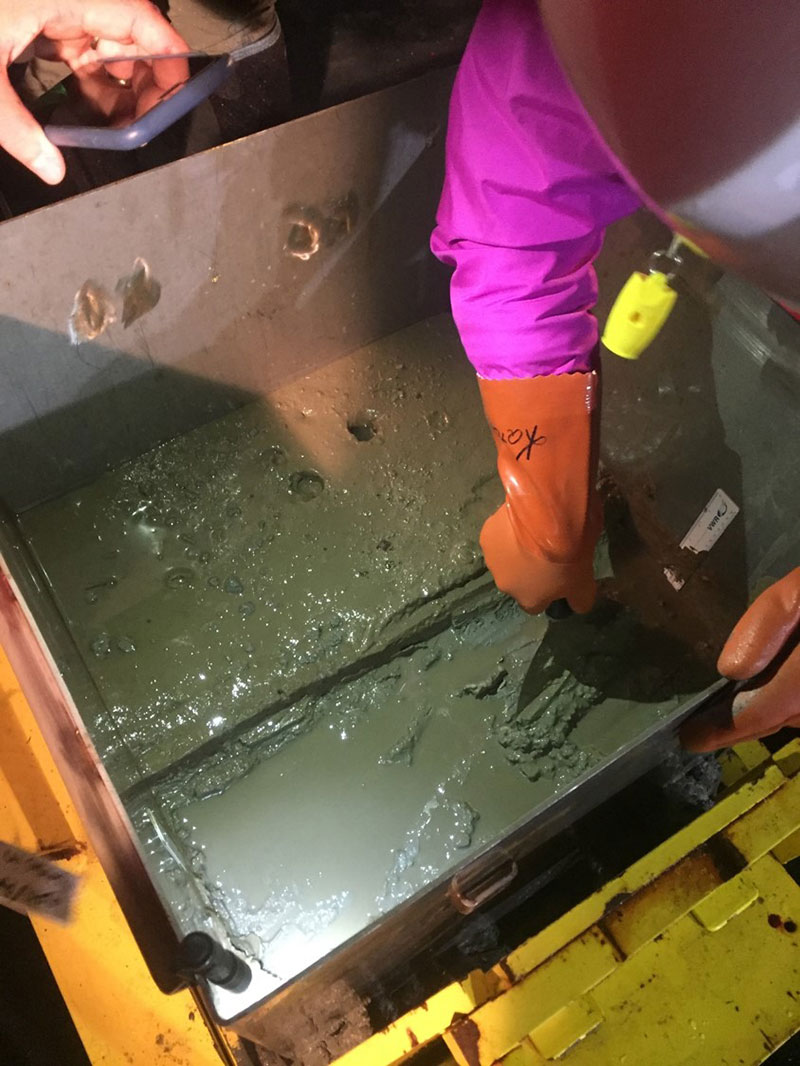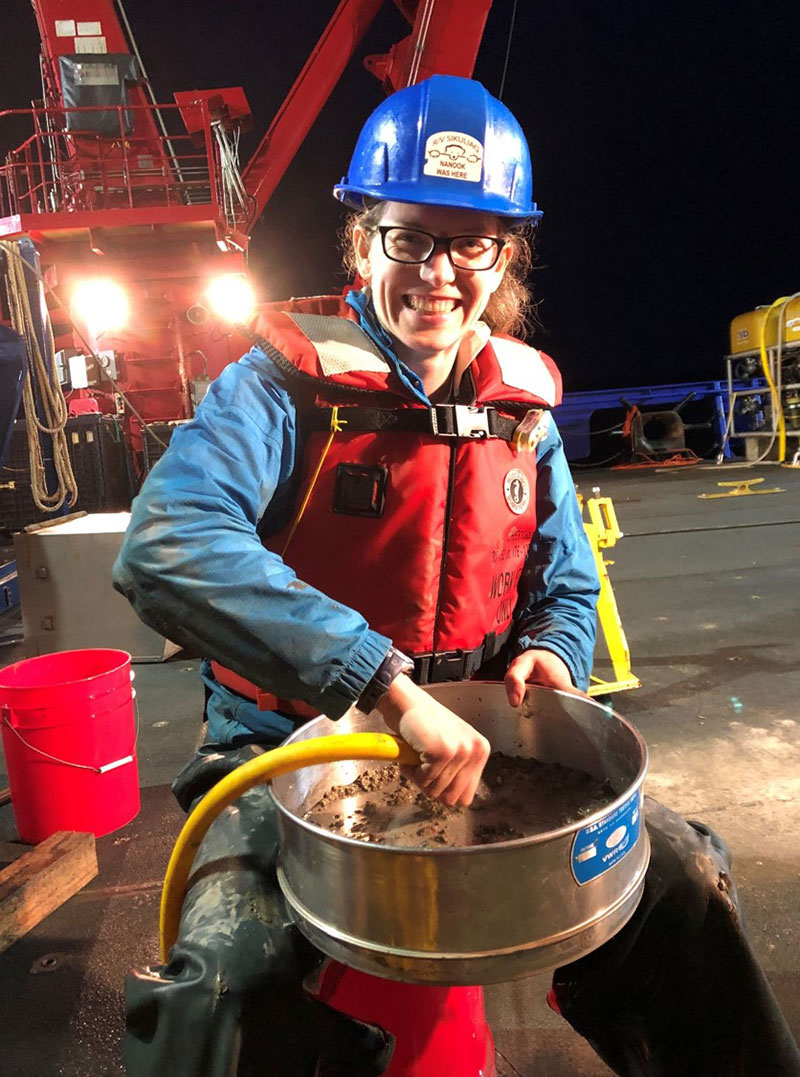
By Brittany Jones, Graduate Student – College of Fisheries and Ocean Sciences, University of Alaska Fairbanks
July 26, 2019

The box corer is on deck and it is a success – there is mud! Image courtesy of Brittany Jones, University of Alaska Fairbanks. Download larger version (jpg, 705 KB).
It’s 11 o’clock at night, the sea is calm, the sky is foggy, but a beautiful shade of deep blue. Donned with hardhats and lifejackets, two scientists hold tag lags securing the box corer as the bosun and marine science tech guide the yellow frame off the deck and out over the water. We pull off the tag lines and watch the corer sink into the depths of the ocean. It’s our first station and our first deployment of the box corer, a device that samples sediment from the deep ocean.
As the returning box corer nears the surface, we jokingly make bets with the bosun about whether or not the corer will actually come up with any sediment, affectionately referred as “mud.” The bosun has been out with us on many past cruises, mainly using a multi-corer, and we all know that getting sediment isn’t a guarantee. As the box corer breaks the surface, we hurry to hook on the tag lines in order to safely guide it back on deck.
With seawater gushing out from the bottom of the box, our hopes for sediment are extinguished. On deck, we inspect the corer and quickly see the problem. One side of the metal box is completely bent out of shape. We hit a rock.

The mud inside the box corer is carefully sliced and sampled for a large variety of scientific analyses. Image courtesy of Brittany Jones, University of Alaska Fairbanks. Download larger version (jpg, 419 KB).
After some contemplation, we decide not to try again. We don’t want to risk destroying either of our other two spare boxes. There will be other stations, and we’ve come to accept that things like this will happen when doing research at sea. Back in my stateroom, it’s past 3 am before I fall asleep, having fueled up with a little too much coffee in preparation for a full night of coring, not expecting it be cut so short.
The following evening, it’s only 8 pm, still light out, the sky a beautiful tinge of evening blue with cloudy white highlights. We are at it again. This time, we have high hopes of successful coring, because the remotely operated vehicle video stream from earlier in the day showed us a seafloor of soft mud, now that we are at a different station. Perfect conditions for coring.
At 2,500 meters (~8,200 feet) depth, we have just over two hours to wait until the corer is back on deck. A lot of time to wonder what we are going to find when it comes back up. Two hours later and we can’t contain our excitement. Success! A box full of mud. We hurry to change out the box to redeploy for the second of three replicates. Luckily, we still have two intact boxes, so we don’t have to process the sample before sending the corer back overboard.
Now completely dark out (what a surprise it was to see total darkness in summer coming from Fairbanks where it still doesn’t ever get completely dark out at this time of year), we work under the ship’s flood lights taking subsamples of sediment for macrofauna, meiofauna, chlorophyll, grain size, and organic carbon content, which we will process back at the lab in Fairbanks.
We finish in plenty of time to have everything sampled, preserved, and cleaned up before the second box is onboard. After the third replicate, we hit the showers to wash off the mud that inevitably covers our faces and crawl into bed as many people are waking up for breakfast. We are tired but happy with the night’s adventures and our newly acquired collection of mud.

Brittany Jones is carefully rinsing the top layer of the mud over a fine mesh to look for tiny critters inhabiting the deep sea. Image courtesy of Katrin Iken, University of Alaska Fairbanks. Download larger version (jpg, 550 KB).